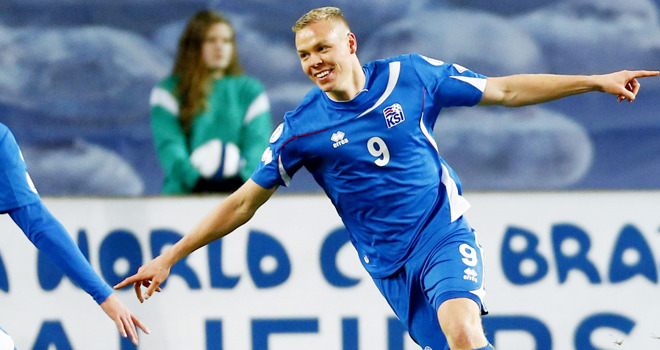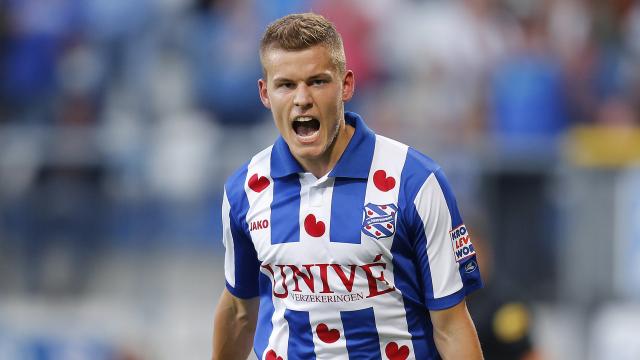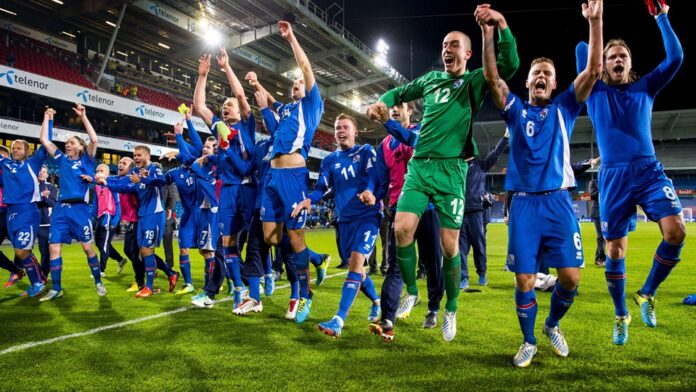Last October, the small yet spectacular island of Iceland came within ninety minutes of World Cup finals football. Only a 2-0 defeat in Zagreb to Croatia prevented a nation of 320,000 – a number only just greater than the population of Wakefield – from taking their team, born of ice and volcanoes, to the tropical climes of Brazil.
This play-off came after the side had defied FIFA World Rankings to finish second in a qualifying group containing Switzerland, Slovenia, Norway, Albania and Cyprus. The group, admittedly, lacked any of the giants of European football, but also was free of any true minnows – indeed, Iceland were the lowest ranked side going into qualifying at 130, directly below Gambia and Tanzania.
Almost 1% of the island’s population travelled to Ullevaal Stadion in Oslo to see the 1-1 draw that cemented Iceland’s place in their first ever World Cup playoff, the greatest achievement in the island’s footballing history.
And now, after the disappointment of Zagreb, they have kept up their World Cup momentum and sit top of their Euro 2016 qualifying group with nine points from three games. Wins of 3-0 in Turkey, 2-0 in Latvia and most recently 2-0 over World Cup semi-finalists from the Netherlands have thrust Iceland into the glare of public interest and have put the minnows of Europe on the brink of summer football at last.
So how has a country that has never qualified for any major international tournament and has for the majority of its competitive existence has sat just a tier above the likes of San Marino and Luxembourg in the European hierarchy suddenly become a contender, among those for whom a place at the world’s premier international tournaments is a very real possibility?
Icelandics in English Football
For some years now Iceland has been represented in the top tier of English football. Hermann Hreidarsson and Heidar Helguson enjoyed success in the Premier League, while Eidur Gudjohnsen reached the very top of domestic football in a career that took him to Chelsea and Barcelona, winning league titles at both.
But now, Iceland are able to boast a group of players all peaking at the same time, a golden generation that has grown up together and is reaping the fruits of experienced leadership…
Gylfi Sigurdsson and Aron Gunnarsson, stalwarts of the Icelandic central midfield, need no introduction to followers of English football.
Sigurdsson, through stints at Reading and Spurs, and now at Swansea, has gained renown as a creative and attractive player, blessed with an incredible ball-striking ability that manifests itself in the guise of stunning goals and set-pieces. This past set of internationals has produced two more vignettes for the scrapbook: showcases of excellent close control in Latvia and anticipation against the Dutch, both with typically emphatic finishes.
Gunnarsson has been a regular for Cardiff since being bought from Coventry in 2011. A tough tackler, the 25 year old has been named national captain since Gudjohnsen bowed out of the international game after the Croatia defeat.
But alongside these two there are other key players in the sudden increase in Icelandic fortunes that may not be so familiar to the casual supporter.
Lars Lagerbäck:
Bearing the flag for the Icelandic football revolution is the wizened Swedish coach. By far the most qualified coach to lead the nation, Lagerbäck took charge of his native Sweden in 2000 and led them to the second round of the 2002 World Cup, topping a group containing Argentina, England and Nigeria, before falling to Senegal. Two years later his side were a penalty shoot-out defeat to the Netherlands way from the semi-finals of Euro 2004. By the end of his reign, he had led Sweden to five consecutive championships for the first time in their history.
Sweden may dwarf Iceland in both size and footballing tradition, but he is no stranger to nurturing a group and taking them beyond expectations. A short and unsuccessful stint in charge of Nigeria in 2010 preceded his appointment in the north Atlantic in late 2011.
The team he inherited had just finished second bottom of a Euro 2012 qualifying group comprising of Denmark, Portugal, Norway and Cyprus. Rather than making wholesale changes to the squad, and throwing a talented but unexperienced cohort of young talent into a qualifying campaign containing two of the same nations that had left their predecessors with just four points, Lagerbäck gradually integrated young players into the existing squad, allowing them to find their international feet.
Kolbeinn SigÞorsson:
Despite having amassed only 26 caps, the 24 year old is already Iceland’s third highest goalscorer of all time with 16 international goals to his name. Highly-touted from a young age, the striker from Reykjavik was linked with big European clubs and had trials at Arsenal before joining AZ Alkmaar at 17.
After time in the AZ youth system and a delayed start to professional football due to injury, he burst onto the Eredivisie scene in his first year of senior football, notching 15 goals in 19 league starts. That total included a five goal haul in a 6-1 thrashing of VVV Venlo: the rosy-cheeked striker exhibited pace, power and anticipation, as well as an ability to score with both feet and his head as he scampered past Venlo defenders time and time again on his way to a perfect hattrick – and then some. So impressive was SigÞorsson’s season that Ajax stumped up a reported €4.5 million for the then 21 year old.

Although injuries have hampered his development at Ajax somewhat,he played a significant role in taking three consecutive Eredivisie titles to the Amsterdam Arena, scoring 24 goals in 59 league appearences (40 starts).
SigÞorsson was seemingly close to a move to Queens Park Rangers this summer, with Marc Overmars – now Director of Football at Ajax – confirming at one point that a move was imminent, but the young striker has remained in the Netherlands and has started the season with 3 goals in 7 games as Ajax sit second in the table.
Alfred Finnbogason:
An injury to SigÞorsson meant that for the match in Zagreb – the most important in Iceland’s history – Gudjohnsen was partnered up front by Finnbogason, a 25 year old striker for whom success did not come as early in life but is wasting no time catching up.
Once two years as a teenager living in Edinburgh while his father studied in the city hadmade him a Hibernian fan, Finnbogason returned to Iceland to become a part of the youth system at Breiðablik.
The club, lying on the edge of the Greater Reykjavik area, has an impressive list of recent alumni: Sigurdsson, Jóhann Berg Gudmundsson (of whom more later) and USA international and Icelandic dual-citizen Aron Jóhannsson all started their careers at the club, as well as a host of other recent Iceland caps.
Finnbogason helped Breiðablik to their first ever major domestic trophies, winning the Icelandic Cup in his first season before clinching a first Úrvalsdeild (the league title) for the club in his sophomore season, contributing enough with his 14 goals in 21 starts to seize the Player of the Year award. After a trial with Blackpool and a couple of years in Belgium with Lokeren, he too made the move to the Netherlands, signing for Heerenveen August 2012 for €500k.

Two years in the Eredivisie has proven more than fruitful. A brace in his home debut against Ajax set the tone, and by the end of his debut campaign he had notched 24 goals in just 33 games. He bettered that last season with 29 goals in one fewer contests, becoming the league’s top scorer – Only Luis Suarez, Cristiano Ronaldo and Jonatan Soriano of Red Bull Salzburg scored more goals across Europe’s top divisions – and the object of many clubs’ desires.
Celtic were priced out of a move in January, and it was Real Sociedad who stumped up the €8 million required to gain his services in July. Injuries have kept him from starting a game in La Liga and have also hampered his involvement in recent internationals. It remains to be seen how he will adapt to the challenge of Spanish football.
There’s not a great variety in the goals that Finnbogason scores, he is a poacher pure and simple relying on a quick burst of short-distance pace and an eye for a finish to rack up his astounding recent tally of domestic goals. A return of 4 goals in 21 international caps, only ten of which have been starts, will only rise as he sees more regular starts following the retirement of the elder statesman Gudjohnsen.
Jóhann Berg Gudmundsson:
Creating the opportunities for Finnbogason and SigÞorsson to rack up their impressive goal-scoring records is Charlton’s Jóhann Gudmundsson, a 23 year old, direct left-footed winger able to play on either flank who nicely exhibits the intertwining nature of this Icelandic generation’s careers.
Like Finnbogason, part of Gudmundsson’s childhood was spent in Britain: he spent two years in London with his family, first playing under 16s football with Chelsea before contact with Heidar Helguson took him to Fulham. A cruciate injury hindered his career in west London and a dislike for the big city led to him leaving his parents and moving back to his childhood Breiðablik, where he played alongside his fellow British exile.
One year of senior football was all it took for Alkmaar – serial poachers of Scandinavian talent – to sign him to supplement the young striking talent of SigÞorsson. In fact in that hammering of Venlo that really announced the striker to Dutch football, it was Gudmundsson that bagged the other goal.
Having moved to Alkmaar as a 19 year old, Gudmundsson quickly became a first team regular, making 119 league appearences and playing a large part in four Europa League campaigns before returning to London this summer – a city that must have grown on him in the interim – to join the Addicks upon the end of his contract.
Though his pace is mainly used for creative purposes, he has a penchant for a spectacular goal. Three of his four international goals came in a 4-4 draw in Switzerland on the road to Brazil: all of them corkers. The fourth in particular, an injury time minute equaliser that kept Iceland in the running for second place in the group, stands out. Receiving a cross-field ball five yards outside the area, the winger took one touch to set the ball in front of him and without a moment’s hesitation sniped the ball through a crowd of covering Swiss defenders, curling it past the grasping arms of Diego Benaglio and in off the far post. A beauty.
Like Finnbogason, Gudmundsson has been beset by injuries at his new club.
It is testament to the newfound depth of Icelandic football that despite these injuries, plus a knock that meant SigÞorsson was not as effective as usual, Iceland have started the new qualifying campaign so explosively.
Alongside the attacking youth that provides such an effective outlet on the counter is an experienced back line, with Rotherham’s Kari Arnason and Ragnar Sigurdsson, now of Krasnodar in Russia, in the heart of defence. Nevertheless, Iceland’s surge into relevance is based on their newfound attacking prowess, provided by the flair of those already mentioned and the resilient battling of wide midfielder Birkir Bjarnason.
The current success has been building for some time. In 2011, the nation reached the u21 European Championships for the first time, beating Germany 4-1 along the way. Sigurdsson, Gunnarsson, Gudmundsson, SigÞorsson, Finnbogason and Bjarnason were all in that squad. It may not be the Germany cohort that demolished England in the 2009 final before growing together to become World Champions this summer, but still this a Golden Generation in the truest sense.
Improved indoor facilities and artificial pitches, as well as an extraordinary amount of coaching talent (for every 33 registered players there is a coach of at least UEFA B qualification, as opposed to 176 in England), an increased opportunity for talented players to seek professional development away from the semi-pro Icelandic league and a genuinely talented crop of youngsters all peaking at the same time have led to Iceland reaching levels never before seen, and suggest that this small island in the North Atlantic could be punching above its weight for some time yet.
The extended format of 2016’s European Championships could finally give Iceland and their young generation of stars a chance to grace the biggest stage of international football at last.




